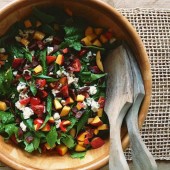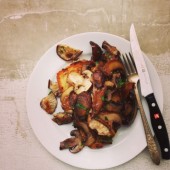If there’s a more Fall-spirited, festive, happy-making dish around, please fill me in.
Let’s talk about ingredients first, starting with this squash. (I know, I know, three straight weeks of squash…next week will be squash-free, promise).
The name “Carnival” really sums it up. This squash makes me want to throw on a party hat and blow on a plastic kazoo. Am I the only one?
Carnival squash is a heritage breed and can usually be found at your local farmer’s market. If you’re really lucky, lighting strikes, and you’re there on the right day, you can find them at Whole Foods. Especially around Thanksgiving when Whole Foods erupts into a massive delivery channel of straight-from-the-farm produce, from Winter greens to Winter squash, Garnet Yams, and everything in between.
The Carnival squash’s skin ranges from dark green to vivid orange, and the flesh is sweet and a little spicy. I’ve got to be careful about using the word “flesh” since my kids erroneously presumed that I was feeding them humans when we did our mystery food challenge last week. I assume that you won’t make the same mistake. We don’t eat humans in our house, and neither should you.
If you’ve been reading my posts, you’ll know that I have a habit of prepping ingredients right after I get home from the store. Prepped ingredients are far easier to incorporate into quick-fix meals, so I usually slice and roast squash with nothing but olive oil, salt and pepper, and then figure out how to use it at a later time.
Likewise with homemade stock. Whenever I’m at the store, I pick up a few extra pieces of bony/collagen-filled meat, which I make into stock that can either be refrigerated for a few days, or frozen. If you’ve ever wondered who that person is buying up those packages of chicken backs, lamb necks, or chunky pork bones – that would be me. They’re cheap, and the bones give your stock incredible body.
This week, partially owing to deep-seeded pre-Thanksgiving behavior as opposed to actual need, I made turkey stock. We’re traveling to California this year for Thanksgiving, but rote habits forced me into buying turkey wings when I was at Whole Foods last week. This is about the time of year when I naturally prep turkey stock for all of my Thanksgiving sides and life wouldn’t feel right if I didn’t do it. There is nothing like the smell of turkey stock simmering on the stove – it’s different from chicken stock. Gamier, heartier. And like all stocks, it makes use of the odds and ends that I so frequently find in my fridge – fresh herbs, carrot trimmings, the middle three pieces of celery that are yellowing and starting to flop.
Pack the stock into individual containers and you’ll have enough for several meals. Rest assured that you’ve made a damn good stock when you remove one of your containers after a night in the fridge and the contents wobble. Think turkey-flavored Jell-O Jigglers.
I had roasted squash and homemade turkey stock on hand last weekend when we headed up to the lake. I’ve been making quite a bit of soup lately, but sometimes I’m hungry for something a little more substantial. I found a bag of barley in my pantry, and the wheels started to turn.
For the past few years I’ve been making risotto-style dishes with grains other than rice. I’d ordered “Farotto” during one memorable dinner at Mario Batali’s Lupa, which was his version of risotto, using Farro grains instead of the typical Arborio or Canaroli rice. By using the same technique – one that I’ll simply call the old Italian grandmother technique of slowly stirring a sautee pan of rice over low heat, coaxing out the creaminess with each stir – you can achieve the same result with a variety of grains and even beans. I’ve tried Farro, Barley, and cannellini beans, all with the same delicious result.
Now that I had squash, stock, and barley, I just needed a few more supporting players.
Wine is an important ingredient in any risotto. Do I keep cooking wine on hand? Never. The stuff that’s sold at the grocery store bears little in common with the wine that I typically drink at home. We don’t drink expensive wines at home since you can find so much value in wines in or below the $20-$25 range. Plus, when I’m cooking, I generally don’t use more than a splash, but it adds great flavor – so make it a worthwhile splash.
Last, but certainly not least – I needed fresh herbs. Sage & squash is a natural flavor combination, and it just so happens that last week’s frost didn’t kill off the last of my herb garden. My leafy herbs didn’t fare as well, but the heartier sage, rosemary and thyme are still standing tall. This is actually the same sage plant that I received as part of my Bialas Farms CSA last Summer – I’ve been cutting it back and letting it grow, enjoying an abundance of sage for the last few months. Hard to believe what one little plant can provide.
Risotto is a simple dish. While it takes some patience and love, if you’ve done it once, you’ll never have to consult a recipe again. Simply sauté a few onions, toast your grains, add your splash of white wine, and then relax into an easy rhythm of stock, stir, stock, stir. Its meditative, and best done if you pull up a stool, and pour yourself a glass of white from the same bottle that you’ve used for your cooking.
This recipe veers from tradition in two important ways – 1) barley instead of rice, and 2) adding the pureed squash to the dish as it finishes. It gives the risotto a comforting and Fall-like twist, and makes it salty/sweet, one of my favorite flavor combinations.
Enjoy with some white wine, or drink as we did – with a nice big bottle of Chimay beer, whose crisp sweetness is a great compliment for the risotto.


Finish the dish simply, with some of Vermont Creamery’s maple & sea salt butter, a healthy dose of Parmesan, and some freshly-ground black pepper. And surround yourself with gourds. Lots of gourds. The uglier the better. Make your table laughable with seasonality. And embrace the moment, because this, truly, is Fall at its best.
- 2 carnival squash
- 4 tablespoons of olive oil, divided
- 1.5 quarts of homemade chicken stock
- 1 medium onion, diced
- 1 cup of barley grains
- 1/3 cup of white wine (any will do, just make sure it’s not too sweet, like Riesling as there’s enough sweetness from the squash)
- 2-3 tablespoons of chopped fresh sage
- 1/3 cup of Parmesan cheese
- 2 tablespoons of maple butter (I love the Vermont Creamery brand)
- Salt and black pepper, to taste
- To prep the squash, heat your oven to 350 degrees. While the oven is heating, slice the squash in half, and scoop out the seeds. Drizzle each half with 2 tablspoons of olive oil, and sprinkle with salt and pepper Roast with the skin side up for 45 minutes, or until tender (the squash should be easily pierced with a knife). Let cool. (PS, in the image, I’d cut my squash into wedges since I’d made it in advance without plans for it – cutting the squash in half cuts down on your prep time). At this point, you can remove the squash meat from the skin, and place in a bowl, and use your immersion blender to puree. Conversely you can use a blender or a food processor, but the immersion blender makes things super simple.
- When you’re ready to make the risotto, heat your chicken stock to a simmer. In a large sauté pan, heat the remaining 2 tablespoons of olive oil on medium heat, and then add your onion. Cook the onion until translucent (approximately 5-7 minutes). Add your barley, and stir in the onions until well coated, and toast in the oil for a minute or so. Reduce your heat to low.
- Add the white wine, and cook until the wine has been incorporated into the grains (a minute or so), and then ladle in your first cup of the simmering broth. Cook, stirring so often, until the liquid has been absorbed. Once absorbed, add another ladle of stock. Continue this process until the barley has become tender. Given that barley is always slightly chewy, it will never get totally soft, but you’ll know when the grain has become pleasantly tender instead of tough to chew. The process will take about 45 mins to an hour, depending on how old your grains are.
- When the risotto has cooked fully, season with salt and pepper to taste, and then stir in the squash puree. It will take a minute or two to heat through and blend in with the risotto. You may need to whisk or stir fairly vigorously to blend.
- Stir in the chopped sage, and add most of the Parmesan cheese (leave a few tablespoons to top at the table). Add the maple butter – if you don’t have maple butter, a knob of unsalted butter and a touch of real maple syrup will do – and stir until the butter has melted and the risotto is glossy. Taste once more for seasoning, adding more salt and pepper to taste if necessary.
- Serve in bowls with Parmesan and freshly-ground black pepper on top.
- I haven't included the recipe here for chicken stock – use your favorite version, or follow this recipe: Pan sear 2 turkey wings in olive oil in a Dutch oven, and then add your vegetables – carrots, celery, onions, and herbs including parsley, bay and thyme. Add a few black peppercorns, fill with water (topping the vegetables and meat by a few inches), bring to a boil and then simmer for a few hours until golden.

















Lovely Jess. Thanks for the delicious recipes. Gorgeous photos!
Thanks as always 🙂 xox
Nice twist on the rice risotto! Sounds delish, will give it a go!
I love risottos with different grains, they’re awesome, definitely give it a go!
photos look amazing
I am a massive squash fan.
Yes, me too, if you haven’t been able to tell from the last few posts 😉
Hum I like the idea of adding the purred squash, makes for a hearty dish.